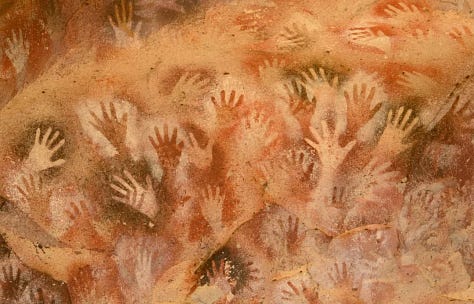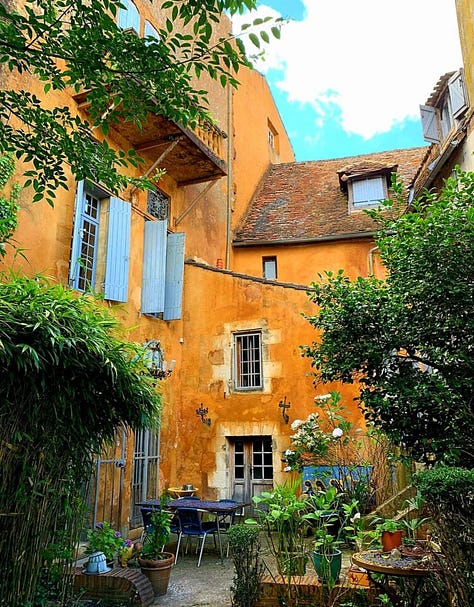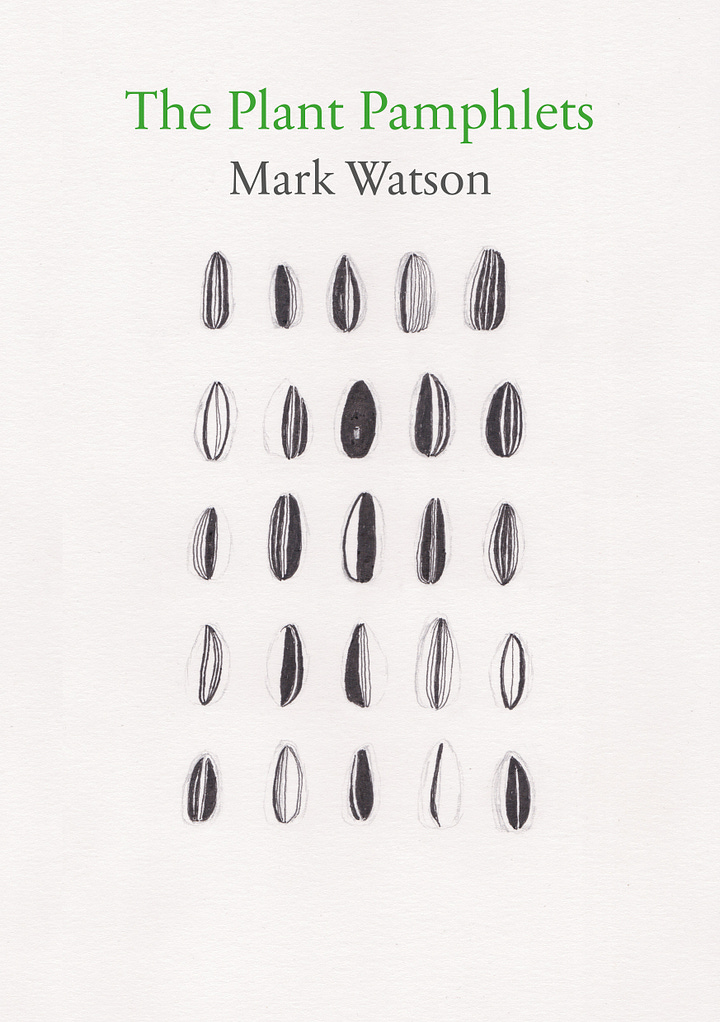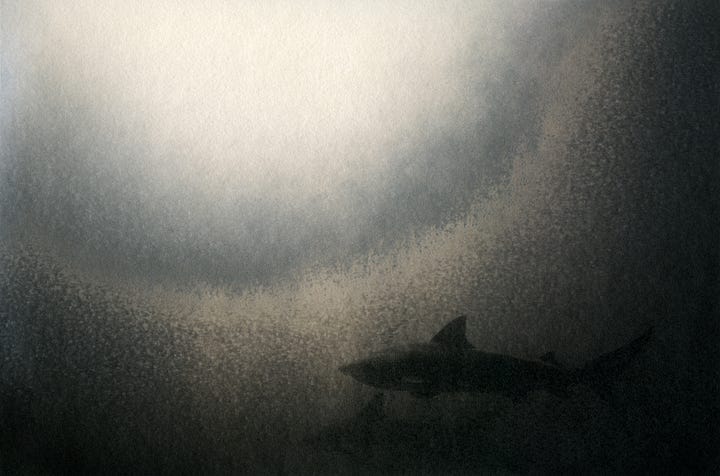Last autumn equinox when the wind changed, I sat at the entrance of a red tent at the end of a Suffolk garden and began to write the first of a sheaf of Substack posts. My intent was to pass on some of the metaphysical practices I had been engaged in with my partner Mark Watson over 35 years. Here I sit, looking back at the writing tracks of that cyclical year, as the sunflowers begin to seed. The buzzards are still wheeling overhead, and the arc of winter stars, but Mark is no longer in the house. At least not in his physical form. It is a soberer time now and its mood fits this pivot in time. as the growing world, and you, and our civilisation begin to go under.

… originally Persephone did not ‘fall’ but deliberately went down into Pluto’s kingdom at the request of Rhea, her ‘grandmother’, the ancestor of the wild earth, to put the world of agriculture, the world of civilisation, back into balance. Once there she did not ally herself with Pluto but joined with her half-brother Dionysus, and their fall-and-return mysteries made a way through for human beings to remember their glorious origins and return whence they came, a way open to all those who journey into the wild, uncharted territory of themselves.
From 52 Flowers That Shook My World – A Radical Return to Earth
A strange thing happens with death: a break with time. You find yourself standing like the famous angel of History, no longer facing forwards anticipating the unknown, but blown backwards, your past life coming to meet you, all its scenes and encounters, pivoted on a single catastrophe. Suddenly, the stories and myths you once read about going down into the Underworld become a bitter reality. You sense the dark river water as you brush past the branches of willow and white poplar. More of you lives there now.
At the entrance of the cave, the cellar of an old house in southern France, I am holding a branch of bay leaves and the people are silently filing past, going down the stone steps into a dark candlelit space. Their scent is intoxicating. The burning leaves of this evergreen tree once inspired the Sibyls of the ancient world, and perhaps here at this equinox, we too can gaze into the mythic void and glimpse what lies ahead.
The autumn equinox marks the moment of the Great Mysteries that were celebrated for thousands of years at Eleusis in Greece. They were shaped by the descent of Persephone into the Underworld, who goes to meet her counterpart Dionysus, wreathed in ivy.
Tuning into this moment, we put our hands in a circle on the stone floor of this chamber to connect with the ground, with the underground caves of the Dordogne where the painters once squeezed through rock to an inner sanctum to depict the valleys’ wild creatures and leave their handprints in charcoal and clay. Look at our hands, I say, they haven’t changed in thousands of years, our ancestral bodies, our human hearts beating.
Afterwards we talk, holding the sticks we collected from the riverbank. We talk of the sacrifices we will make for the future, the comforts and hiding places that keep us separate, the dead wood of ourselves that will feed the fire. The fire will light our way through the stony passages of time, so we can carry its warmth with us as we descend.
When we throw them all into the fire in the house, it roars.
Mark was supposed to be here by this fire, not me. He was planning to visit Bergerac to the ‘praxis hub’ run by Life Itself, and meet the people who once formed our online lockdown sangha. So when I was invited to take part in a residency on deep adaptation and community resilience there this September, I said yes. I’m going for you, I told him, as I sat beside the group of giant sunflowers grown from his shoebox seed store. I’m going to cook with Valerie, and have a glass of wine outside in a cafe on a warm evening with everyone.
Pattern language



I have embedded most of the Red Tent practices in the territory where I live on the Suffolk coast, following the shape of the year, its equinoxes and solstices. I’ve shared the kernel of the metaphysical teaching Mark and I once did in a series called The Labyrinth and the Dancing Floor, and my writing classes in another called The Uneasy Chair.
My intent was to collate them in a way that I had come across in a visionary architectural book called A Pattern Language. It is a compendium of sorts, both an analysis and love song to the vernacular of places, the physical relationships that makes us feel at home in the built world, with the alleyways, window seats, market squares and cafes of traditional settlements. I wanted anyone to walk around our practices and know them as you might recognise the blue shutters of this house, or the sounds and scents of the Bergerac market. They would feel familiar, even though you had not come across them before. Pulled together across time, they would make a certain shape in space, a knowing you could feel deep in your bones.
This house is a traditional three-storied building in a small square by a park and the river Dordogne. Tiled roof, tall windows, coloured walls, tiled floors and a magnificent wooden staircase. A laundry room, a piano, an open fireplace. As soon as you walk through the iron gate to the courtyard garden, you feel at home.
In these rooms in this week we share workshops, a play reading, talks, several curated conversations, river swims, meals made by us all and glasses of local beer and wine outside in the cobbled streets in the warm evenings. Valerie and I walk down to the river and pick almost-autumn leaves – Canadian fleabane, small-leaved mallow, plantain, nettles, Michaelmas daisy flowers, wild carrot seeds, with mint and thyme from the garden, and some market kale - and make a celebratory pile of Mark’s famous Flexible Fritters.
He would have loved to be here, cooking these himself for you, I tell the assembled company. He would have brought laughter too, and raised an eyebrow at some of my wilder interjections.
We are having conversations about the future around tables. Outside in the garden, Lucas, philosopher-nomad, construction worker, and one-time sailor and surfer of the Pacific coast, tells us about the book he is writing on city-dwellers and the perception of ‘nature’; how in the arts residency he runs in the north of France, people lose patience with the coffee machine when it goes wrong. So long as the machine keeps working he says, people don’t care about understanding it. But when it stops, they just keep pressing buttons, expecting it to work. We all recognise the metaphor.
In the upstairs ‘painting room’ there are two lively salons with Stephen Markley author of The Deluge, an epic novel about social and climate collapse. The book is a macro-narrative related through a collage of texts and scientific papers, and the micro-lens of several characters – a deeply researched no-holds-barred look at what might play out from now to 2040. In the public talk, there are people from Plum Village, a Buddhist monastery and retreat centre nearby, and there is a push-back against the tsunami of bad news that Stephen brings in his wake. Some imagining we have an aeon of time for enlightenment, others almost none.
‘It’s physics and chemistry!’ Stephen says, exasperated, at one point. The spiritual people want the crisis to be about their inner worlds. the author wants us to understand what is happening in the big picture, to ‘electrify everything before it is too late’. Someone talks about the left and right hemispheres that govern our perception, as if it were a choice, rather than fostering a capacity to master the art of both. A chasm opens it seems hard to bridge.
Except for artists and writers, whose work it is to create those metaphorical bridges, so we can somehow, literally, be on the same page, and not lose it when the machine stops working.
Back up crew
On the second day, I give a workshop about imagination and resilience, and connecting with our ‘back up crew’. We’re not going anywhere without the planet or the ancestors, I say, and invite everyone to speak about their heartlands and lineages, the knowledge we carry in our bodies and imaginations. We need to feel our feet and hands, stretch our awareness to allow more breadth and depth in the world, and know we are not alone. Unless we do there will no space for the future to reveal itself.
Our teachings were always about fostering these creative exchanges and ‘increase ceremonies’ with others. The warmth generated between people creates a shape that holds everyone’s difference and similarity, a web of correspondences where each thread matters. As an individual you can write a ground-breaking book but not hold the whole story. Every writer knows that. In this week in this house you can feel what holding that non-linear story within a group might mean. The challenge is to take it out afterwards into a hostile culture captured by history and the lure of machines.
I used to say that Mark came from the future and I came from the past and that the Fates had brought us together to meet in this troubled present. We relinquished our old lives and were never able plan ahead. Instead, we developed practices so we might live in a an expanded sense of time where all knowledge and all possibilities could exist, following the ancestral ‘stone clock’ of the eight fires that illuminate the cycle of the solar year.
What we found was that the future you might wish to live in is not something that you can engineer, it already dwells inside, a state of coherence and generosity that needs to be remembered. Once you are there, you know everything is worthwhile. You open up like a flower. The hard thing is to maintain this alignment and not close down. Data might give your mind reasoning, spirituality release you from its turmoil, but only the Earth can hold you in it leafy arms, in its salty embrace, in its fiery core, only the heart can hold a harmonic with your fellows.
This equinox morning, at the end of the residency, I stand at the balcony overlooking the square, towards the bridge where the sun is rising though I cannot see it. We cannot see the future either, but sometimes we can feel, it. It feels familiar, as if we have been here before but have forgotten, a pattern we have chanced upon and consider ourselves lucky: the sunlight on the stair; a friendly meeting under banana trees, It feels like your energised body as you emerge from the river, or hearing how Valerie and Liam found themselves crying at the stove when they made those wild fritters for Mark at spring equinox. It is made of tenderness, and a love of place, and the contemplative depth of a kiva. It feels like this moment of quiet rain, trickling through the oak leaves and roof tiles, a town waking up on a Sunday morning, as if Mark were standing beside me. A still point. A question. Can we start again?
Bookshelf
A year ago I sat in the reading room of the Library of Birmingham with a new notebook open and a sharpened pencil. I had just finished teaching a writing class at my old university and had been shocked by the changes I saw: the buildings, the atmosphere, the corporate surfaces slicked over everything. Some things though had not changed. As I took a bus from my old (now gentrified) neighbourhood, I noticed with delight the traditional Indian sweet shop still on the Mosely Road with its brightly-coloured shapes in the window, and the tiled Edwardian swimming pool, where, we used to go for hot baths in our squatting days. Oh, nostalgia! you might say: but this was not sentiment. The relationships with place, with things, hold a kind of knowledge you cannot learn in the lecture hall. The intelligence of how to be in this world is kept in its physical fabric, how we touch, feel, pause by, pass through, smell and listen. When it goes, that knowledge goes too.
Some books you once loved don’t disappear either. They remain sharp in your memory for a single treasure they have bequeathed you, a message from your lineage of writers and metaphysicians, a vital link. They are threads in the fabric of your shared intelligences and form a pattern language of their own. When you are young and a student of literature, you read thousands of books. Most you forget in time. But then there the ones that you retain as markers for the way you perceive the world after encountering them. Those are the texts that open your eyes, challenge your mind, startle your heart awake. Some of these I wrote down in the notebook that day as I waited for the London train.
The end sections of these Substack posts have put most of that list of remembered books on its virtual bookshelf. They have ranged from esoteric plant knowledge to writing non-fiction to Indigenous future-thinking, and included sculpture by Joseph Beuys, a film by Andrei Tarkovsky, and a one-man play about getting lost in the Amazon rainforest,


However since the spring equinox, I have been focused on producing two new Dark Mountain books, soon to arrive from the printers. And if you would like a peek into their pages, here are two invitations to their online launches: the first is for Dark Mountain: Issue 26 - Dark Ocean on 18th October; the second for Mark’s Plant Pamphlets on 1st November. It would lovely to see you at either or both of them.
POSTSCRIPT By Gare du Nord, I sit down and weep
I don’t know what made me cry suddenly but when I look around me in the carriage as the train back hurtles back to Britain beneath the sea every single person is on their smart phone. Even the young girl opposite is holding a tablet and wearing earphones, screwing her face up at some imaginary game. It’s a truism, but perhaps the reason I weep is from feeling that howling absence, the loss of presence. Hundreds of people silently connected to machines taking them everywhere elsewhere except here. It’s the very opposite of the French house, the circle our hands made on the stone floor. The very opposite of Mark waiting on the platform at Darsham to greet me on return with a bear hug. Hello Charlie, are you hungry? he would say, I’ve made some supper in the oven. A Ukrainian woman glances up from her screen and offers a glass of water, and tells me she has lost her mother recently.
I have been wearing my sorrow like a coat, keeping the memory of Mark wrapped up around me, but I know those who go down into the Underworld lose everything, especially the warmth and comfort of clothes. Inanna is stripped naked as she steps through the seven doors of the kur; Psyche holds an empty casket and the goddess of love’s stern instruction. Why do we follow in their footsteps? Because though we might mourn, like Demeter, the loss of this lovely bright Earth, all its wondrous patterns and shapes, all those flowers and salad days, swimming in the summer sea, we know in its depths lie the seeds of everything that lives and breathes, and that our leaving behind nourishes them in their dark hour. How we experience this knowledge in life is the core of the mysteries, what our ancestors crawled into the caves to paint, its fierce animal beauty, to remind those who follow, that all life comes out of the dark. We go down to reawaken those seeds, to keep life going, to know its true value. That is what Psyche finds when she disobeys the instruction and opens the box: the invisible gift of Persephone. Regeneration.
This October I will post my contributions to Dark Ocean and The Plant Pamphlets, and also take a pause to see if there is a future for The Red Tent. For now, I thank you all for reading these posts and especially to my paid subscribers who have helped support me with funds during a tumultuous year. Have a great autumn all!
With many thanks to my fellow future beings: Liam Kavanagh and Rupert Read of the Climate Majority Project for inviting me to France and to uncivil savant Caroline Ross for looking after our cottage and cat in Suffolk so I could go.



I deeply value your posts here, your writerly voice and insights, your stories. They are so important. I hope you keep with The Red Tent!
Very beautiful and moving. Thank you